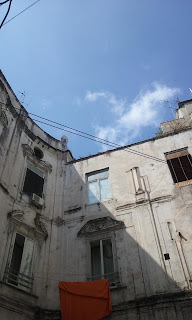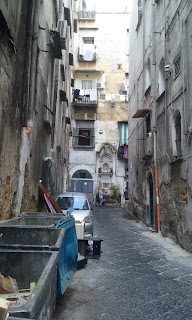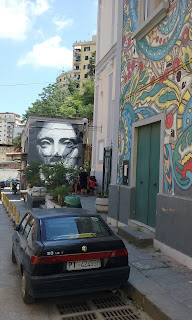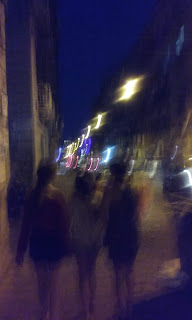
 |
| Marchello Mastriani and Sophia Loren, "Matrimonio all'italiana" (1965) |
"That's Vesuvius right?" I asked the cab driver taking us from the airport to Naples.
He nodded his head.
Graffiti is everywhere.
"That's the way New York used to look," smiled Caroline.
Our friends Greg and Molly met us.
And we walked for days together, celebrating a moment in time,
now past, as old lives died, and new lives took shape.
Its hard being here not thinking of them.
First, i sat on the roof in the terrace taking in the majestic city, cars zooming up and down the promenade.
"Do dove sei?"
"New York City," we tell the waitress, sitting in an outdoor cafe.
"I want to go to New York city."
"The people there are all crazy."
"More than here?"
"Yes...."
Its the most pulsing city space I know, full of a history of pagans and writers, revolutions and conquests, socialists and reactionaries, and the travelers who have come here and been changed by the space.
"I won’t say another word about the beauties of the city and its situation, which have been described and praised often," Johann Wolfgang von Goethe famously wrote about the space during his trip here. "As they say here, “Vedi Napoli e poi muori! — See Naples and die!” One can’t blame the Neapolitan for never wanting to leave his city, nor its poets singing its praises in lofty hyperboles: it would be wonderful even if a few more Vesuviuses were to rise in the neighbourhood."
You can only start to dig through the layers the space.
Elena Ferrante writes about feeling a sense of forboding when invited to take a ride with some of the wrong kinds of boys, "to see how beautiful Naples is, the most beautiful city in the world..."
She demures in My Brilliant Friend, her bildungsroman of growing up in the city.
With each successive page, the story of the city comes leaping out of the text.
"Naples, he said, has always been like that, its cut down, its broken up, and its rebuilt and the money flows and creates work."
The city is full of layers and history, of people born in their parents hands, growing up in the markets, who have walked here, were born here, and brought a piece of that to the world.
So, we walked for a few days.
The first night we wanderred through the historic district. The next morning we woke up late and made our way out into the Sanità district of the Stella quarter, just north of the historical centre, adjacent to the Capodimonte hill.
The last time, we made our way through here, Molly was flirting with a policeman who suggested we stay away from the Catacolms. This time, we kept on walking there, making our way between the shops, kids riding scooters without helmets, taking in the lost majesty of this space, brimming with vitality. The Saturday markets thriving with men selling fish, food everywhere, everyone in the streets. These are the streets where Marchello Mastriani and Sophia Loren found their way onto screen, pointing to a post War Italian subjectivity, between Fascism and Gramsci. History is curious and complicated here.
Reflecting on city, Sophia Loren confessed:
Scooters zoom.
A woman hangs a bucket below her window, dropping a message for a friend.
Landry dry their laundry from the windows.
Roof gardens bloom.
Every street looks like a work of art, its locomotion thrilling.
We stop for coffee and granitas on Salita Capidomonte. Caroline reads us about the history of the the cult of the dead at the Fontanelle Cemetery in Naples, where we are going. The city cleared the cemeteries out to make room after the plague, warehousing the old skulls and bones. But people came to worship the skulls.
The porous relationship between the living and the dead is everywhere here.
Up we wander to the Catacombs of San Gennaro, the underground paleo-Christian burial and worship site we missed the last time we were here. Carved out of tuff, a porous stone, they hold a distinct chapter in the early history of Christianity here. Initially a space for pagan burial, this underworld for the dead, was later adapted into a Christian burial ground after the second century AD. When San Gennaro was buried here, lots and lots of people wanted to be buried near his remains. People fought over these remains, stealing them at one point. Walking through the dark catacombs, our guide shows us frescos made by both the pagans and the early Christians, including one of a 4th century fresco of a peacock thought to embody eternal life. She shows us another of a vase of grapes, making use of a pagan imagery, used to convey Christian meanings. Wine for everyone.
Our guide tells us about the social collective she is involved with - the Paranza Collective - to preserve the history of the catacombs, the nearby hospital and supports for kids looking for work in the neighborhood. There has to be another story to this neighborhood she insists. Please tell everyone this story she insists.
And we keep on walking to the Fontanelle cemetery in Naples, a charnel house, and ossuary, located in a cave in the tuff hillside in the Materdei section of the city. The folklore around the space is abundant. Full of skulls people once worshiped, this is an eerie image of faith and the porous relationships between the living and the dead.
Walking I'm reminded that Italy shows us so much of what is bountiful and possible, the art, the food, the people, even of their remains, which they worship here.
This is a city of layers.
The Catacolms and Fontanelle Cemetary remind us of this.
"Naples is one of the clearest examples of cities where history can be traced through its "layers".The Greek Neapolis and the present-day city are not separated by millennia but but metres of soil under the ground. The past is not placed in a glass case or forgotten, but peeps out in some parts of the present-day city. This coexistence of eras has acquired increasing value in the city's economy, through the integration of archaeological finds in contemporary public works, such as the Municipio station on Metro Line 1.
"I won’t say another word about the beauties of the city and its situation, which have been described and praised often," Johann Wolfgang von Goethe famously wrote about the space during his trip here. "As they say here, “Vedi Napoli e poi muori! — See Naples and die!” One can’t blame the Neapolitan for never wanting to leave his city, nor its poets singing its praises in lofty hyperboles: it would be wonderful even if a few more Vesuviuses were to rise in the neighbourhood."
You can only start to dig through the layers the space.
Elena Ferrante writes about feeling a sense of forboding when invited to take a ride with some of the wrong kinds of boys, "to see how beautiful Naples is, the most beautiful city in the world..."
She demures in My Brilliant Friend, her bildungsroman of growing up in the city.
With each successive page, the story of the city comes leaping out of the text.
"Naples, he said, has always been like that, its cut down, its broken up, and its rebuilt and the money flows and creates work."
The city is full of layers and history, of people born in their parents hands, growing up in the markets, who have walked here, were born here, and brought a piece of that to the world.
So, we walked for a few days.
The first night we wanderred through the historic district. The next morning we woke up late and made our way out into the Sanità district of the Stella quarter, just north of the historical centre, adjacent to the Capodimonte hill.
The last time, we made our way through here, Molly was flirting with a policeman who suggested we stay away from the Catacolms. This time, we kept on walking there, making our way between the shops, kids riding scooters without helmets, taking in the lost majesty of this space, brimming with vitality. The Saturday markets thriving with men selling fish, food everywhere, everyone in the streets. These are the streets where Marchello Mastriani and Sophia Loren found their way onto screen, pointing to a post War Italian subjectivity, between Fascism and Gramsci. History is curious and complicated here.
Reflecting on city, Sophia Loren confessed:
"I exist only because inside of me and above all else I am only and above all a Neapolitan. Naples exists inside of me, and always will. Fortunately for me there is this treasure that I have inside of me and, when I need it, then I pull it out."
There's a majestic confidence to the space. Kids spray paint messages on the walls and even the monuments. Scooters zoom.
A woman hangs a bucket below her window, dropping a message for a friend.
Landry dry their laundry from the windows.
Roof gardens bloom.
Every street looks like a work of art, its locomotion thrilling.
We stop for coffee and granitas on Salita Capidomonte. Caroline reads us about the history of the the cult of the dead at the Fontanelle Cemetery in Naples, where we are going. The city cleared the cemeteries out to make room after the plague, warehousing the old skulls and bones. But people came to worship the skulls.
The porous relationship between the living and the dead is everywhere here.
Up we wander to the Catacombs of San Gennaro, the underground paleo-Christian burial and worship site we missed the last time we were here. Carved out of tuff, a porous stone, they hold a distinct chapter in the early history of Christianity here. Initially a space for pagan burial, this underworld for the dead, was later adapted into a Christian burial ground after the second century AD. When San Gennaro was buried here, lots and lots of people wanted to be buried near his remains. People fought over these remains, stealing them at one point. Walking through the dark catacombs, our guide shows us frescos made by both the pagans and the early Christians, including one of a 4th century fresco of a peacock thought to embody eternal life. She shows us another of a vase of grapes, making use of a pagan imagery, used to convey Christian meanings. Wine for everyone.
Our guide tells us about the social collective she is involved with - the Paranza Collective - to preserve the history of the catacombs, the nearby hospital and supports for kids looking for work in the neighborhood. There has to be another story to this neighborhood she insists. Please tell everyone this story she insists.
And we keep on walking to the Fontanelle cemetery in Naples, a charnel house, and ossuary, located in a cave in the tuff hillside in the Materdei section of the city. The folklore around the space is abundant. Full of skulls people once worshiped, this is an eerie image of faith and the porous relationships between the living and the dead.
Walking I'm reminded that Italy shows us so much of what is bountiful and possible, the art, the food, the people, even of their remains, which they worship here.
This is a city of layers.
The Catacolms and Fontanelle Cemetary remind us of this.
"Naples is one of the clearest examples of cities where history can be traced through its "layers".The Greek Neapolis and the present-day city are not separated by millennia but but metres of soil under the ground. The past is not placed in a glass case or forgotten, but peeps out in some parts of the present-day city. This coexistence of eras has acquired increasing value in the city's economy, through the integration of archaeological finds in contemporary public works, such as the Municipio station on Metro Line 1.
Walking out of the cemetery, I notice an old poster for a Lucio Battisti cover band, dubbed "Emozioni." We have to go, i text Matteo. He's the bard of Italy, he texts back.
"Its the best city in the world," smiled our waiter later that night. "I've been everywhere. London," he gestured. "And i can't say what happened to me in Los Angeles."
Mom joined us and we ate, seemingly reinvigorated.
After dinner the younger gals and i made our way back out into the night, strolling past my favorite park, where a majestic tree extends up several floors just off Largo Donnaregina, hidden away and a part of this delicate urban ecology. People converge outside. It smells like pot. The city is full of secrets. Lots of things go on below the layers here.
"Hello" a man asks.
But for a day, we just walk.
Enjoying a quiet night, we make our way back home.
Its our aniversary. The kids asked us about our years together. So many surprises, including kids.
And then 911, which rattled the self confidence of the city, lunging us into a xenophobic frenzy, which felt afraid of the freedom which the city long represented for everyone. The city became a sort of police state. The public spaces controlled, with freedoms slipping away, as outsiders are detained.
I hope we can get it back.
But i'm not sure.
But its hot. We want something.
A group of people are having a granita outside at a stand.
A bartender furiously stirs lemon granita, sugar, orange, lemon, soda and grenadine.
Whats that called, asks Caroline.
An American, notes the one man, smiling with his wife and kids.
Ironic name.
Its not something you'd get at home.
None of this is.
Mom joined us and we ate, seemingly reinvigorated.
After dinner the younger gals and i made our way back out into the night, strolling past my favorite park, where a majestic tree extends up several floors just off Largo Donnaregina, hidden away and a part of this delicate urban ecology. People converge outside. It smells like pot. The city is full of secrets. Lots of things go on below the layers here.
"Hello" a man asks.
But for a day, we just walk.
Enjoying a quiet night, we make our way back home.
Its our aniversary. The kids asked us about our years together. So many surprises, including kids.
And then 911, which rattled the self confidence of the city, lunging us into a xenophobic frenzy, which felt afraid of the freedom which the city long represented for everyone. The city became a sort of police state. The public spaces controlled, with freedoms slipping away, as outsiders are detained.
I hope we can get it back.
But i'm not sure.
But its hot. We want something.
A group of people are having a granita outside at a stand.
A bartender furiously stirs lemon granita, sugar, orange, lemon, soda and grenadine.
Whats that called, asks Caroline.
An American, notes the one man, smiling with his wife and kids.
Ironic name.
Its not something you'd get at home.
None of this is.















































































































































































































































No comments:
Post a Comment